 |
 |
 |
| |
Even at Counts Over 350,
More CD4s Lower Death Risk in Untreated HIV+ People
|
| |
| |
Note from Jules Levin: This study was in ART naives. Interesting research would be to look at individuals, patients o HAART with high CD4s, say over 800 or 1000 to see if achieving such high CD4s might provide protection and the death rates ma be the same as the general population. However, none of these comparisons can include a consideration of the effects of aging. The question is: when HIV+ individuals reach 65-70 & older yrs of age will there risk for death be higher than the general population and what are the risk factors that increase the risk. Are care providers able to address risk factors adequately including diabetes, rates of which are higher among HIV+, and bone disease, as 60% of HIV have reduced bone mineral density which is a higher rate at a younger age than HIV-negatives. In the general population osteoporosis is a cause for increased risk for fractures and fractures are associated with increased risk for death. So will HIV-positives have greater risk for bone disease ad greater risk for fractures and associated death compared to HIV-negatives.
15th Conference on Retroviruses and Opportunistic Infections
February 3-6, 2008
Boston
Mark Mascolini
Antiretroviral-naive people with more than 350 CD4 cells apparently have a higher death risk than people in the general population, while HIV-infected people in higher 350+ CD4 brackets have a lower risk of dying than those in lower 350+ brackets, according to a 23-cohort analysis involving almost 50,000 untreated people in industrialized countries.
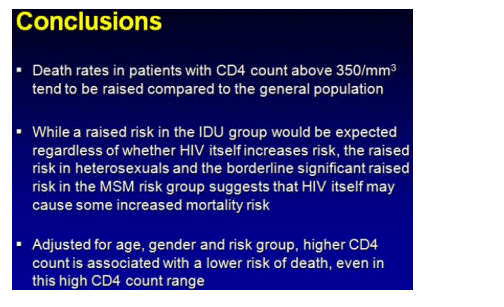
Rebecca Lodwick (University College London) and colleagues analyzed mortality in 46,400 people through 98,527 person-years of follow-up. Everyone had at least one CD4 count above 350 while treatment naive before January 2005. Follow-up ran from the time of each CD4 count to (1) the next CD4 count, (2) the start of antiretroviral therapy, (3) 1 year later, or (4) death, whichever came first. Lodwick calculated age-, country-, and gender-specific standardized mortality ratios (SMRs) for the major HIV transmission risk groups--men who have sex with men (MSM), heterosexuals, and injecting drug users (IDUs)--and compared them with national death rates in the general population.
MSM accounted for 53.4% of the study group, heterosexuals for 21.1%, IDUs for 20.6%, and others or unknowns for the rest. The biggest segment of cohort members, 45.4%, were between 30 and 40 years old, 29.1% were 20 to 30, 18.9% were between 40 and 50, 5.3% were 50 to 60, and 1.3% were older than 60. People with 350 to 500 CD4s accounted for 37.6% of follow-up years, people with 500 to 700 for 34.5%, and people over 700 for 27.8%.
During follow-up 487 people died to yield a death rate of 4.9 per 1000 person-years. While 48.3% of deaths did not involve HIV, 16.2% did, and 35.5% had an unknown cause. IDUs ran more than a 10 times higher risk of dying than the general population, heterosexuals more than a three times higher risk, and MSM only a 21% (marginally significant) higher risk:
· IDUs: 227 observed deaths, SMR 10.21 (95% confidence interval [CI] 8.93 to 11.63)
· Heterosexuals: 82 observed deaths, SMR 3.33 (95% CI 2.65 to 4.13)
· MSM: 117 observed deaths, SMR 1.21 (95% CI 1.00 to 1.44)
In a sensitivity analysis excluding CD4 counts before January 1990, these SMRs remained constant at 10.02 for IDUs, 3.04 for heterosexuals, and 1.37 for MSM.
For every 100-cell higher CD4 count, heterosexuals had almost twice the death risk of MSM (rate ratio [RR] 1.95, 95% CI 1.42 to 2.66, P < 0.001) and IDUs had nearly a six times higher death risk (RR 5.92, 95% CI 4.74 to 7.40, P < 0.001). Compared with men, women had a 26% lower death risk (RR 0.74, 95% CI 0.59 to 0.93, P = 0.0093). As could be expected, older people ran a significantly higher risk of dying for every age bracket compared with 20- to 30-year-olds.
Lodwick cautioned that factors unmeasured in this analysis could result in SMRs that underestimate or overestimate the heightened risk of death due to HIV. That possibility, she added, seems particularly likely for IDUs, but the risk of statistical confounding is less clear for MSM and heterosexuals. While one would expect HIV-infected IDUs to run a higher death risk than people in the general population regardless of whether HIV raises that risk, Lodwick noted, "the raised risk in heterosexuals and the borderline significant raised risk in MSM . . . suggests that HIV itself may cause some increased mortality risk."
Reference
1. Lodwick R, Porter K, Sabin C, et al. Age- and sex-specific death rates in ART-naive patients with CD4 count above 350 cells/mm3 compared with the general population. 15th Conference on Retroviruses and Opportunistic Infections. February 3-6, 2008. Boston. Abstract 141.
ABSTRACT
Age- and Sex-specific Death Rates in ART-naive Patients with CD4 Count above 350 cells/mm3 Compared with the General Population
Rebecca Lodwick*1, K Porter2, C Sabin1, B Ledergerber3, A Cozzi-Lepri1, P Khaykin4, A Mocroft1, L Jacobson5, S de Wit6, A Phillips1, and Study Group on Death Rates at High CD4 Count in Antiretroviral Naive Patients
1Univ Coll London, UK; 2Med Res Council Clinical Trials Unit, London, UK; 3Univ Hosp Zurich, Switzerland; 4Johann Wolfgang Goethe Univ, Frankfurt, Germany; 5Johns Hopkins Univ, Baltimore, MD, US; and 6St Pierre Univ Hosp, Brussels, Belgium
Background: It is unclear whether ART-naive patients with high CD4 count carry a raised risk of death compared with the general population, and whether there are trends in mortality rate according to CD4 count and viral load in this group.
Methods: Using data from 24 cohorts and collaborations in industrialised countries, and using national death rates, we calculated country-, age-, and sex-standardized mortality ratios (SMR), stratifying by risk group. Included patients had at least 1 CD4 count >350 cells/mm3 while ART naive. Follow-up was counted from the time of each CD4 count >350 cells/mm3 until the earliest of: next CD4 count; elapse of 1 year; death; or start of ART. Where available, the most recent viral load value at the time of each CD4 count was identified.
Results: Of 47474 patients contributing 113,643 person-years of follow-up with current CD4 count >350 cells/mm3, 534 (1.1%) died. Most patients were male (75%), 50% were men who have sex with men (MSM), 25% heterosexual, 20% injecting drug users (IDU), and 5% were in the other or unknown risk group. The median (IQR) CD4 count under follow-up was 540 (438 to 700) cells/mm3. The SMR (95%CI) for MSM, heterosexual, and IDU were 1.14 (0.95 to 1.36), 3.07 (2.48 to 3.76), and 9.58 (8.40 to 10.88), respectively. In a sensitivity analysis considering only CD4 counts before January 2005 (performed to mitigate any effect of late reporting of deaths), the SMR were 1.25 (1.03 to 1.49), 3.47 (2.78 to 4.27), and 10.08 (8.81 to 11.49). After adjustment for risk group, a higher CD4 count was associated with a decreased risk of death (per two fold higher CD4 count: incidence rate ratio (IRR) 0.66, 95%CI 0.54 to 0.81, p <0.0001, Poisson regression). Similarly, in 66,665 person-years where a viral load was available, a higher viral load was associated with an increased risk of death (per log10 increase: IRR 1.17, 95%CI 1.03 to 1.34, p <0.0001).
Conclusions: In HIV-infected ART-naive people with CD4 count >350 cells/mm3, death rates tended to be raised compared with the general population. However, for the MSM risk group this was marginal, suggesting that some of the raised risk in other groups may be due to confounding by other factors. Even in this high CD4 count range, lower CD4 count and higher viral load were associated with raised mortality. Although several cohorts are linked with national death records, it is plausible that under-ascertainment or late reporting of deaths has resulted in under-estimation of death rates.
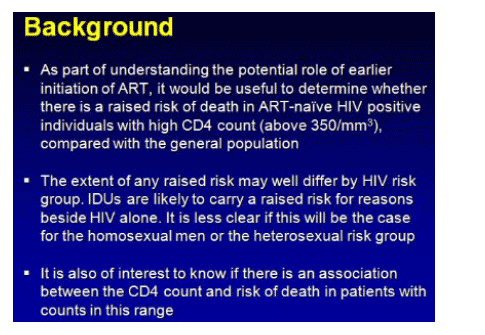
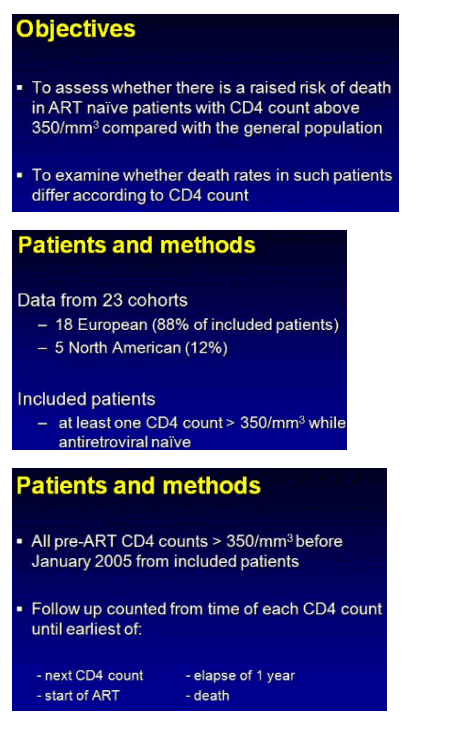

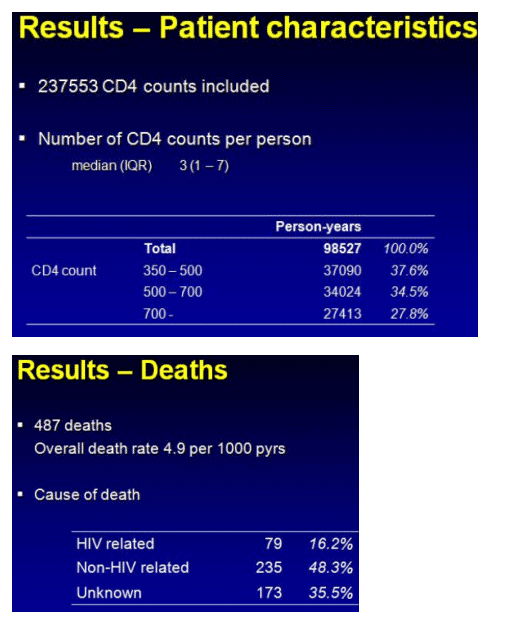
The presenter said if the death rate among MSMs were the same as in the general population there would have been 97 deaths among MSMs but there were 117 giving a risk rate of 1.21.
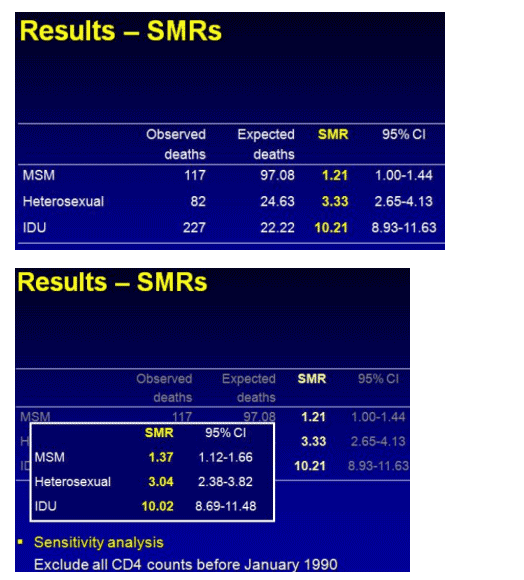
After adjusting for age and risk group, higher CD4 count (every 100 CD4 increase) was significantly associated with a lower risk. Women had a lower risk than men.
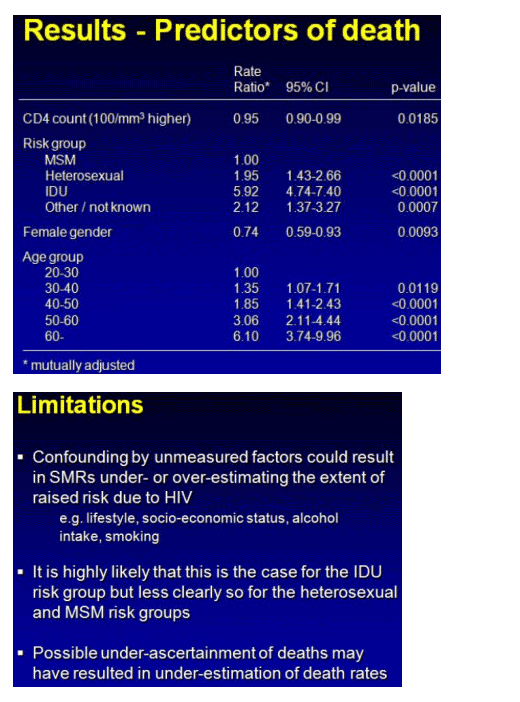
|
| |
|
 |
 |
|
|